Introduction
AWS Lambda and API Gateway are two key components in building efficient and scalable cloud-based applications. AWS Lambda allows developers to focus on writing code without the hassle of managing servers, operating systems, or language environments. It automatically scales with workload and integrates seamlessly with other AWS services, such as the API Gateway, which simplifies the creation, deployment, and management of APIs.
This combination of Lambda and API Gateway offers a powerful and cost-effective solution for developers and organizations aiming to harness the full potential of the cloud. In this article, we will explore the benefits, best practices, integration methods, and advanced use cases of AWS Lambda and API Gateway, providing insights and guidance for building robust and secure APIs in the cloud.
Understanding AWS Lambda
AWS represents a groundbreaking approach to cloud computing, enabling developers to concentrate on writing code without the burden of managing servers, operating systems, or language environments. This zero-administration compute platform executes code in response to events and automatically manages the underlying compute resources, scaling seamlessly with the workload. The integration of AWS services, such as the API Gateway, allows for the creation of scalable and secure serverless APIs with ease.
The efficiency and scalability of the function have been demonstrated in various real-world applications. For example, at Vertex Pharmaceuticals, AWS facilitated the analysis of complex data from drug discovery experiments. Machine learning models, trained and executed within a serverless computing environment, allowed for rapid and accurate image analysis at scale, revolutionizing the way scientists assess the impact of drug candidates.
Furthermore, the architecture of a certain technology has empowered cultural institutions such as the Northwestern University Libraries to embrace the International Image Interoperability Framework (IIIF) API, improving the accessibility and analysis of digital collections worldwide. The capability of handling on-the-fly region selection and its efficient delivery of content only as needed aligns with IIIF's goal of efficient information sharing.
Within the broader landscape of cloud computing, AWS's serverless platform, Lambda, continues to push the boundaries of innovation. The recent release of Amazon S3 Express One Zone showcases Amazon's dedication to high-performance and scalable storage solutions, a philosophy that reflects the vision of serverless future. In the meantime, the utilization of AWS and other AWS offerings in fields such as neonatal neurotechnology and environmental monitoring highlights the adaptability of serverless computing in tackling various and important obstacles.
As we navigate the myriad of cloud computing options, it's clear that AWS stands out for its unique combination of simplicity, efficiency, and integration capabilities, marking it as a pivotal tool for developers and organizations aiming to harness the full potential of the cloud.
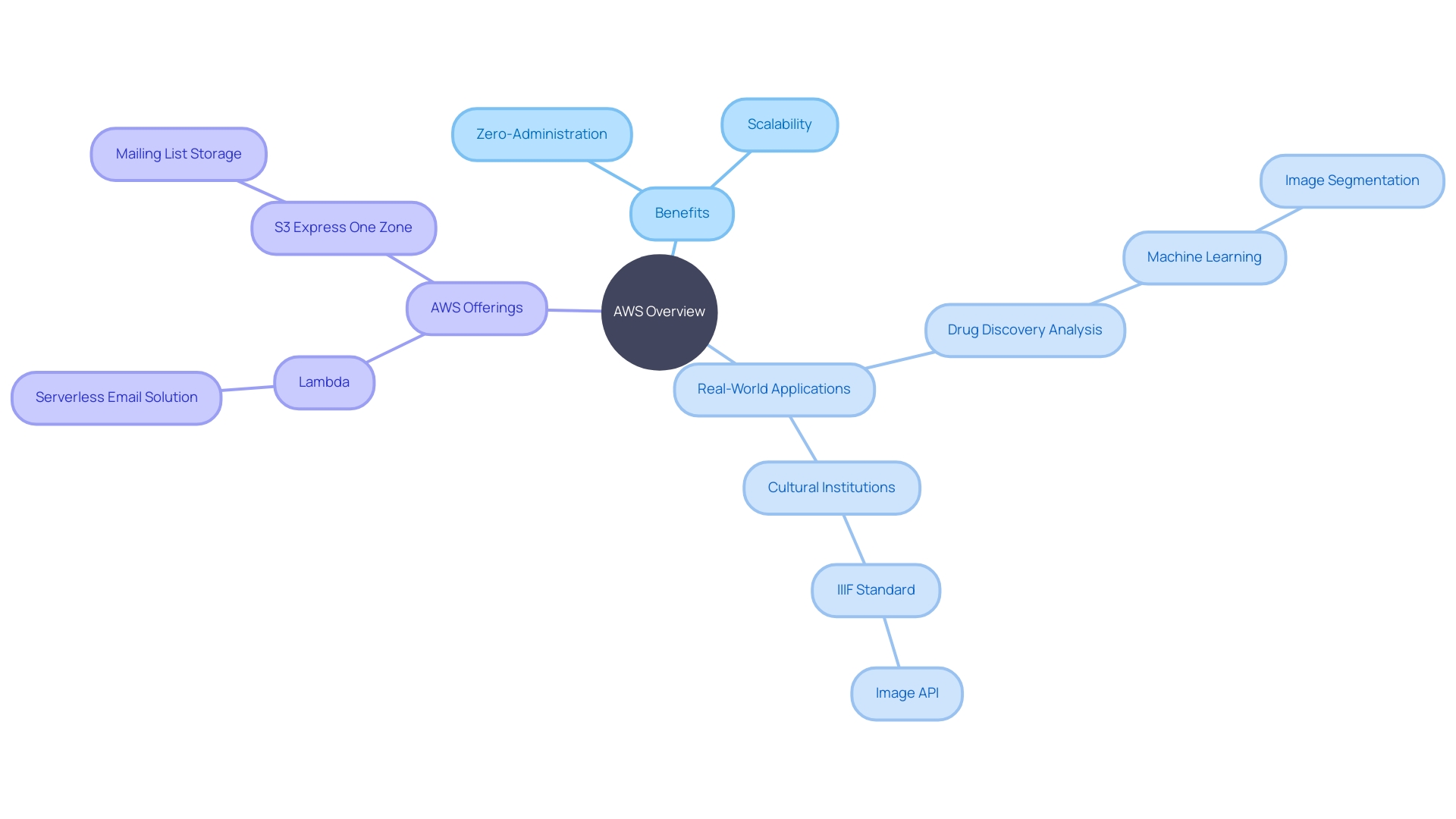
Overview of API Gateway
Amazon API Gateway stands as a pivotal platform for developers looking to streamline their API operations. It simplifies the creation, deployment, and management of APIs, addressing critical needs such as request validation, authorization, rate limiting, and routing. For example, Zurich Insurance Group's digital platform, LiveWell, utilizes serverless technology to provide a scalable, high-availability offering for their users, showcasing the practical implementation of API Gateway in combination with AWS Lambda for efficient operation and cost optimization.
Given the increasing relevance of APIs, as evidenced by a Vanson Bourne study revealing that 93% of organizations consider APIs crucial for their operations, the fully managed nature of API Gateway is a significant boon. This offering assumes responsibility for the underlying infrastructure, encompassing software updates and security, enabling developers to focus on service development rather than management. However, this convenience does come with trade-offs, such as certain limits on request handling capacity.
Comprehending the internal mechanisms of an API gateway can be compared to the role of a maître d’ in a restaurant, coordinating the flow of requests and ensuring seamless interaction between clients and operations. This analogy underscores the multifaceted responsibilities of an API gateway, from managing guest interactions to overseeing the seamless operation of the back-end kitchen, or in this case, the technical infrastructure.
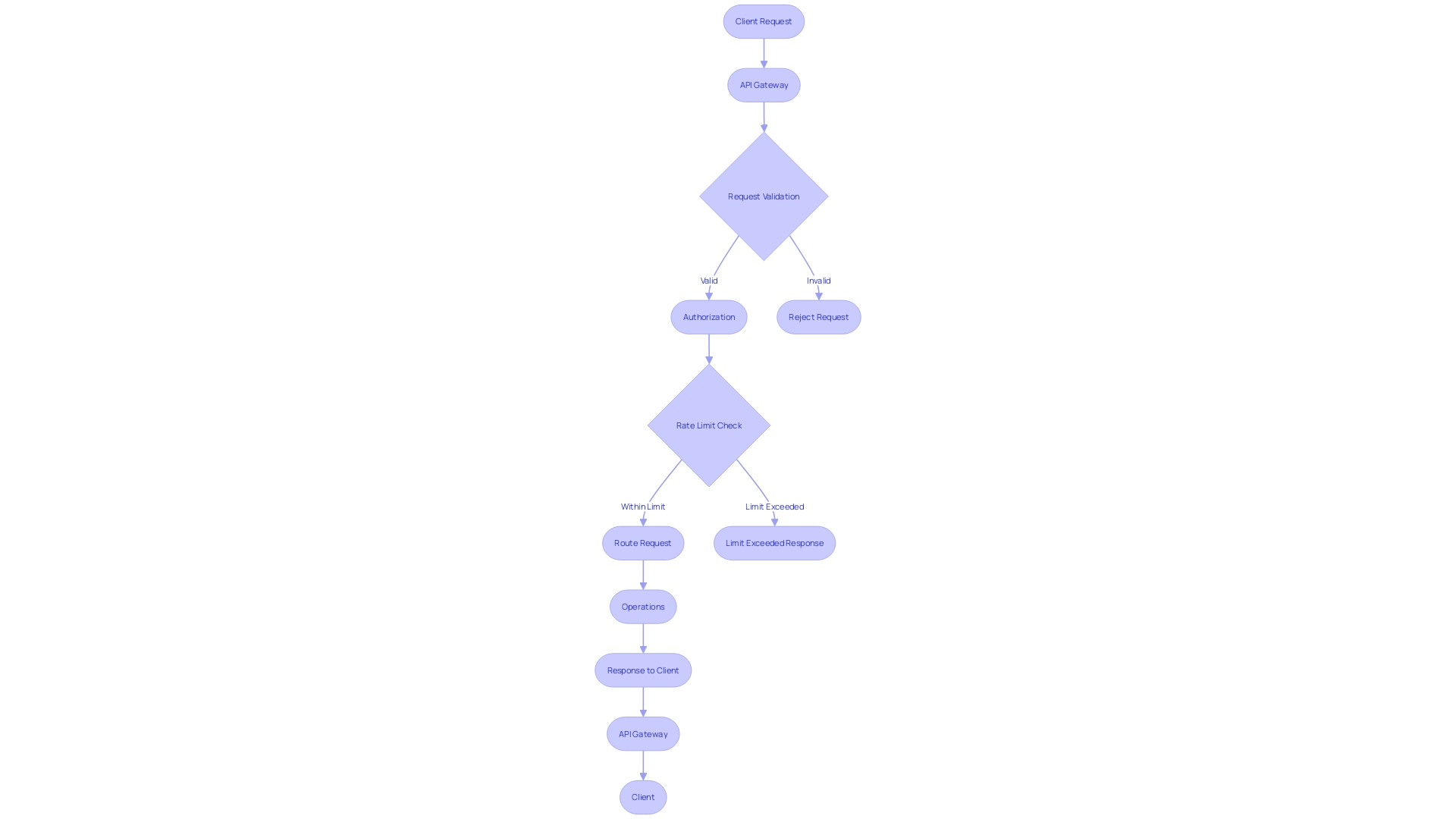
Creating an Amazon Lambda Function
Creating a function is the foundational step for building APIs with AWS, which integrates seamlessly with other AWS offerings to provide a robust backend for your applications. You can start creating your function from scratch, giving you the flexibility to write code in the language of your preference, be it Python, Node.js, or Java. In this manner, you can customize the function to fulfill your particular requirements, from the configurations, the environment variables to how it interacts with other AWS options.
One important factor to take into account is defining your function's endpoint, which can be achieved either directly through the code or by setting an environment variable. Opting for an environment variable, such as ENDPOINT_NAME, allows you to make changes to the endpoint without the need to redeploy the code, streamlining the development process.
Lambda itself is a fully managed offering, meaning you do not need to worry about server management, operating system maintenance, or scaling concerns — AWS handles these automatically. Moreover, it's designed to be cost-effective, as you only pay for the compute time you consume with no charges when your code is not running.
In the context of data management, AWS also offers Amazon DynamoDB, a NoSQL database that provides fast and predictable performance with seamless scalability. DynamoDB allows you to store and retrieve any volume of data and handle all levels of traffic, distributing the data across multiple servers to ensure consistent, rapid access.
As the technology landscape keeps changing, AWS is continuously updating and introducing new offerings to fulfill the needs of developers and organizations. For instance, AWS Innovate Online events offer a glimpse into the latest AWS capabilities across various domains like serverless, AI/ML, and analytics, with opportunities for hands-on experience and learning.
To summarize, AWS Lambda and associated AWS offerings provide a powerful, versatile, and cost-efficient approach to constructing APIs and backend solutions, with the additional advantage of a serverless framework that abstracts away infrastructure management. This allows developers and organizations to focus on creating innovative applications without the overhead of maintaining servers.
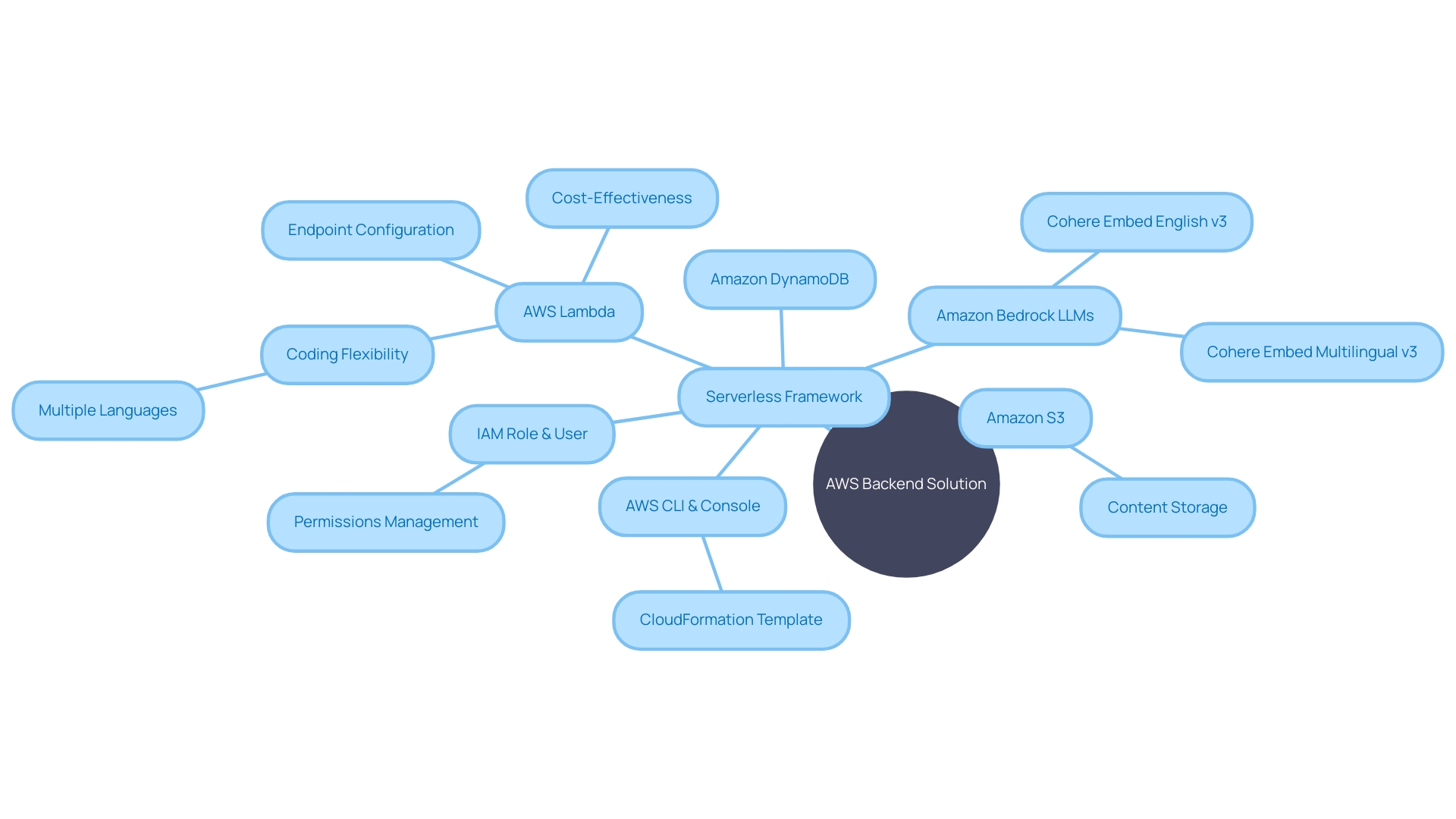
Integrating Lambda with API Gateway
Incorporating your function with API Gateway is crucial for managing API requests efficiently. An API Gateway acts as a front door for your application's data and functionalities, providing a single entry point for all client requests. The integration process involves setting up request validation, authorization, authentication, rate limiting, and routing. Moreover, it allows request and response transformations, which are pivotal for tailoring the API responses to the needs of different clients.
The fully managed nature of an API gateway simplifies the development process by handling underlying infrastructure, software updates, security, scalability, and disaster recovery. As such, developers can channel their focus on service development rather than on the operational aspects. However, this convenience may come at the cost of reduced flexibility, including potential limitations on the number of requests per second (RPS) that the gateway can process.
The significance of APIs in organizational ecosystems cannot be overstated, with recent studies by Vanson Bourne showing that 93% of organizations deem APIs crucial for their operations. Integrating APIs with microservices, as 97% of respondents agreed, creates a cohesive system that enhances performance and can lead to increased customer satisfaction, productivity, and time savings. Therefore, setting up the integration between a serverless function and API Gateway is not just a technical step, but a strategic move that aligns with the growth and demands of modern digital enterprises.
Lambda Proxy vs. Non-Proxy Integration
Selecting the appropriate integration approach between the serverless function and API Gateway is crucial for optimizing API performance and efficiently managing resources. Proxy Integration simplifies the integration process by allowing the API Gateway to forward all request data to the function. This method enables the function to handle the request parsing and response construction, which can be particularly useful for developers seeking a streamlined integration process. On the other hand, Non-Proxy Integration offers more control by requiring the API Gateway to handle request and response mappings, which can be beneficial when a higher level of customization is needed.
With the increasing adoption of APIs, underscored by a Vanson Bourne study revealing that 93% of organizations recognize the relevance and essential nature of APIs, the decision between these integration types becomes even more critical. The same study found that 97% of respondents believe APIs and microservices complement each other, highlighting the importance of effective integration strategies for optimal performance and productivity.
Furthermore, modern enterprises require robust security measures, such as those provided by LDAP Single Sign-On, which API Gateways can support. This integration not only strengthens security but also improves the user experience and operational efficiency—aims that are well-served by a thoughtfully selected function and API Gateway integration method.
Lastly, the scalability of your API is a significant consideration. While fully managed API Gateways offer convenience by handling infrastructure, security, and scalability, they may impose limits on request rates, which could impact your API's ability to scale. Finding the right balance between easy management and the requirement for flexibility and scalability will help you decide whether to use Proxy Integration or Non-Proxy Integration, ensuring that your API meets the needs and growth expectations of your organization.
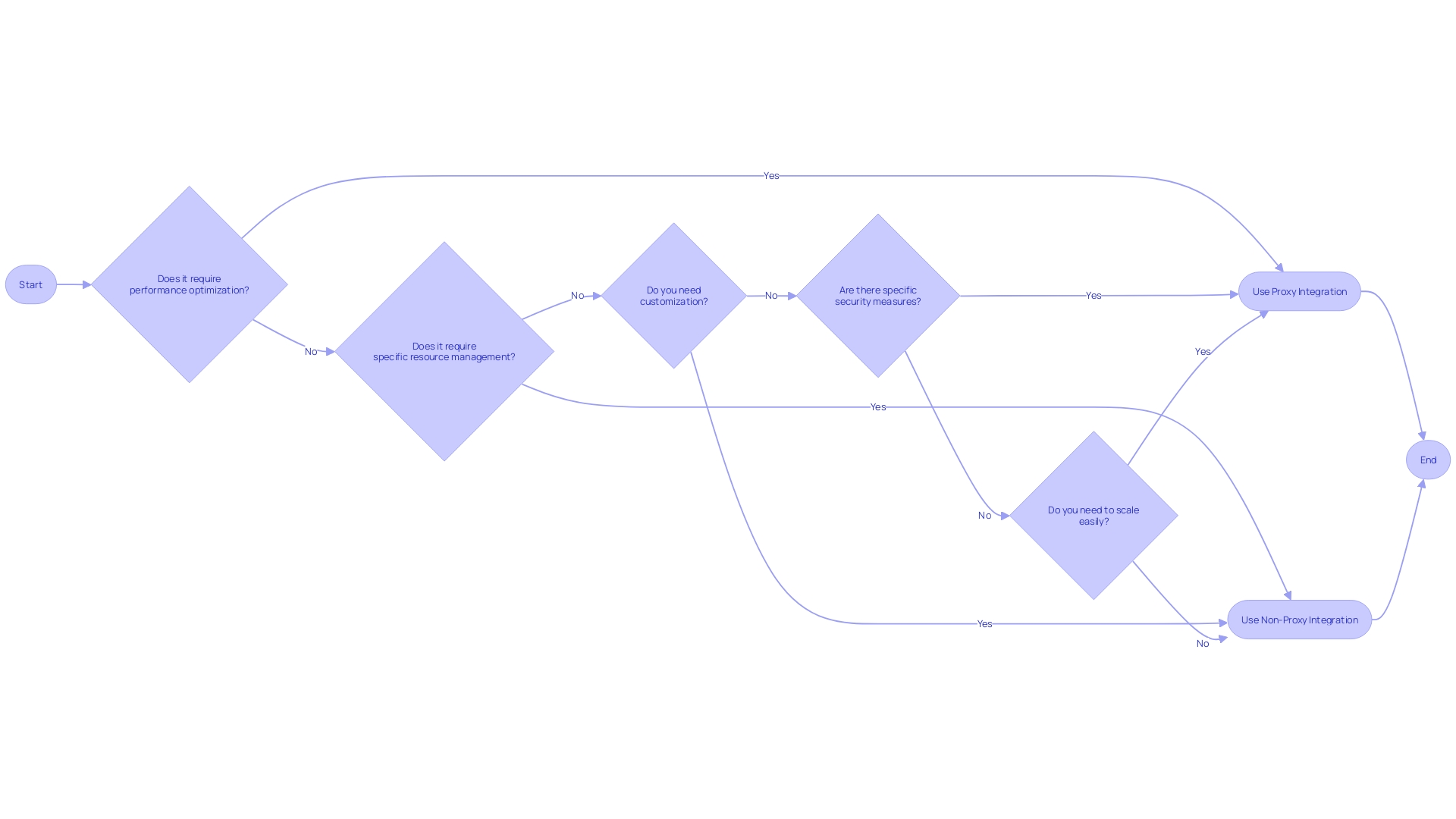
Creating a REST API with Lambda Integration
Starting the building of a REST API with integration through API Gateway requires a comprehensive knowledge of resource definition, method configuration, and the required setup procedures. Functions that are crucial to our conversation should reflect simplicity and the principle of single responsibility. These functions are triggered by specific events and are ideally suited for tasks such as data processing and HTTP request responses due to their serverless nature. They offer the advantages of scalability and cost-effectiveness without the requirement for server management, as stated in 'A Beginner's Guide to AWS Functions'.
When building with serverless architectures like AWS Functions, it's wise to follow recommended guidelines such as maintaining a proper .gitignore file to prevent exposing sensitive AWS credentials. This approach is reinforced in the context of Tofu projects, where the convention dictates that the Lambda function's entry point aligns with the method name specified in the Tofu code. Additionally, leveraging Typescript enhances code documentation and IDE support, further streamlining the development process.
By utilizing API Gateway, a fully managed platform, developers can concentrate on building robust APIs while the management of infrastructure, security, and disaster recovery is taken care of by AWS. This setup facilitates request validation, authorization, authentication, rate limiting, and request routing, as emphasized in the industry insights on API gateways. However, while this abstraction simplifies development, it's important to be cognizant of potential limitations, such as fixed request per second (RPS) thresholds.
The significance of APIs in the digital ecosystem cannot be understated. They have transitioned from simple data conduits to strategic organizational assets. API analytics now play a pivotal role in driving business decisions and enhancing user experiences. The State of APIs, Integration, and Microservices survey by Vanson Bourne in 2021 corroborates this by revealing that 93% of organizations consider APIs crucial to operations. Furthermore, 97% of respondents see the harmonious integration of APIs and microservices as beneficial, leading to improved customer satisfaction, productivity gains, and time savings.
While exploring the details of API creation with AWS offerings, it is crucial to embrace the AWS Amplify console that is geographically nearest to achieve optimal performance, as geographical proximity may affect response time and data transmission rates. The Amplify console provides a user-friendly interface for hosting, with straightforward navigation to initiate the setup process.
Ultimately, building a REST API with AWS resources is a revolutionary process that not only streamlines development but also holds the capability to automate operations and promote innovation. The strategic use of Lambda functions coupled with the managed convenience of API Gateway forms a powerful duo in the realm of cloud computing, allowing developers to produce scalable and secure APIs that support organizational growth and digital transformation.
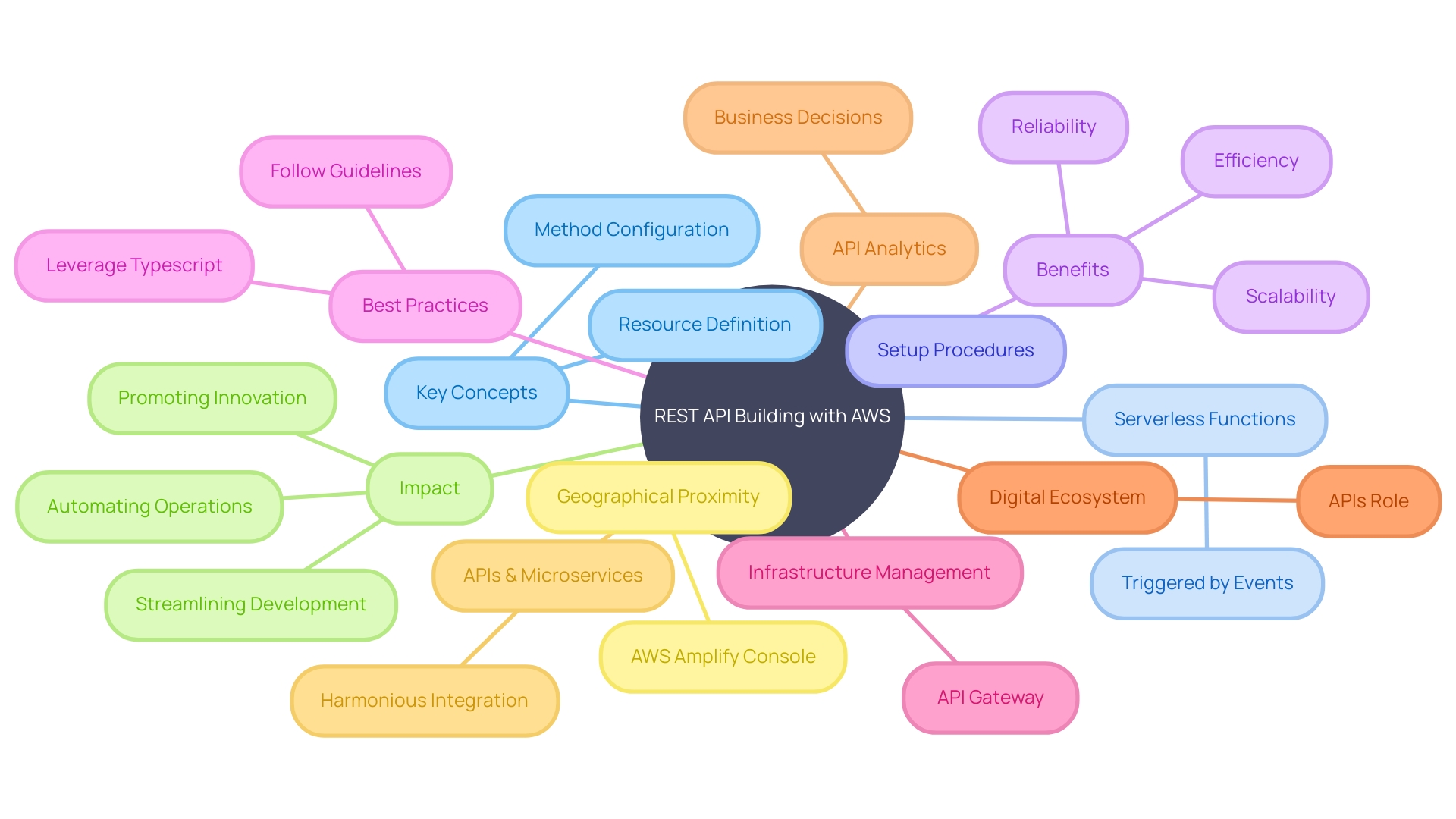
Configuring API Gateway for Lambda Functions
Amazon Web Services (AWS) offers a strong API Gateway feature, allowing developers to create, publish, maintain, monitor, and secure APIs on a large scale. One of the key advantages of the API Gateway is its fully managed nature, allowing developers to delegate the responsibilities of infrastructure, software updates, security, scalability, availability, and disaster recovery to AWS. However, this convenience does come with certain trade-offs, such as a limit on the number of requests per second (RPS) that the platform can handle, which could impact flexibility.
Integrating API Gateway into your architecture allows for advanced configurations that can significantly enhance your API's functionality. For instance, request and response mappings enable the transformation of incoming requests and outgoing responses, facilitating compatibility between different systems and data formats. Error handling capabilities aid in providing detailed information when an API call fails, which is essential for debugging and maintaining the quality of performance. Moreover, the caching feature can reduce the number of calls made to your endpoint and improve the latency of requests, thereby offering a better experience to the end-users.
With the continued growth and relevance of APIs in modern tech infrastructure, as evidenced by a Vanson Bourne research indicating that 93% of organizations consider APIs essential, it is crucial to harness such features effectively. The API Gateway's functionalities are designed to streamline the development process, enabling businesses to focus more on innovation and less on the operational complexities of API management. As the technology landscape evolves, AWS continues to innovate with events like AWS Innovate Online, offering a platform for teams to engage in solving technical challenges across various domains, including serverless and analytics, further emphasizing the importance of staying current with the latest advancements in API solutions.
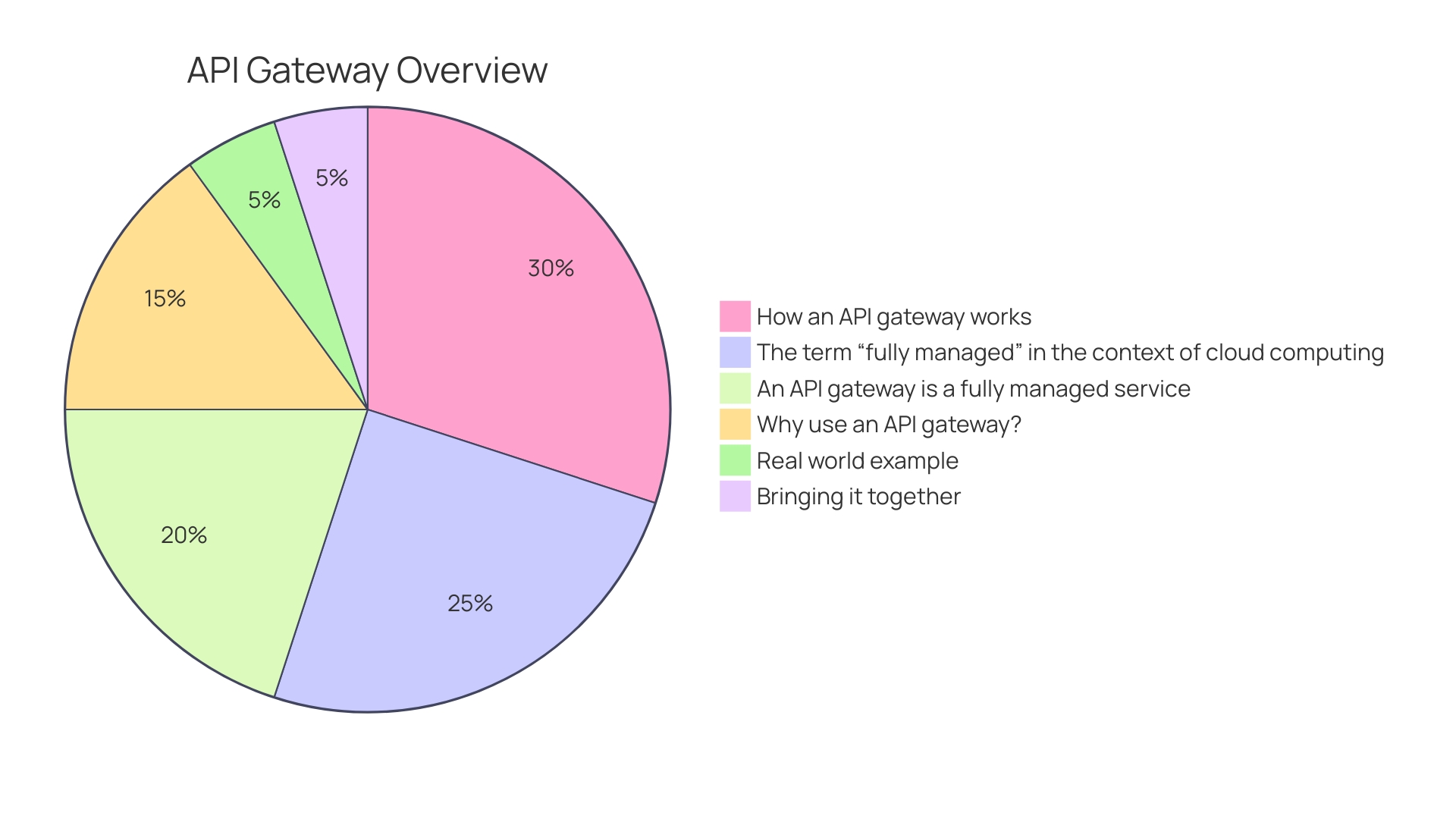
Testing and Deploying the API
When preparing an API for production, meticulous testing is paramount to ensure robust functionality and integrity. Leveraging tools like the API Gateway console or command-line interfaces, one can simulate real-world usage scenarios that validate data integrity and compatibility with various systems. For example, in the context of testing a weather data API, comprehensive test data should encompass a variety of cases, including boundary conditions, edge cases, and non-destructive interference checks, to ensure the API can handle diverse inputs such as 'maximum hail size' with resilience.
The refinement process also involves performance considerations, where load balancing plays a critical role. A well-designed API should distribute workload effectively, preventing any single server from becoming a bottleneck, thus enhancing throughput and fault tolerance. This is where modularity and statelessness come into play, as they allow APIs to be both scalable and maintainable, adhering to RESTful principles.
Furthermore, real-world examples and analogies can provide clarity on the importance of an API gateway. It acts as a intermediary between user interfaces and servers, overseeing communication and enabling developers to concentrate on building functions rather than on infrastructure management.
As stated by experts, 'Security is important. Compatibility with other systems is important. These things are important to the end users of products or services, and to people who assist them It is therefore essential to approach API testing not merely as a routine check but as an experiential process that requires testers to adopt the mindset of external developers, exploring the API's functionality through practical, developer-centric scenarios.
Incorporating these strategies and principles, from test data generation to load balancing and modularity, ensures that your API is not only ready for deployment but also poised for scalability, reliability, and seamless integration in the ever-evolving landscape of software development.
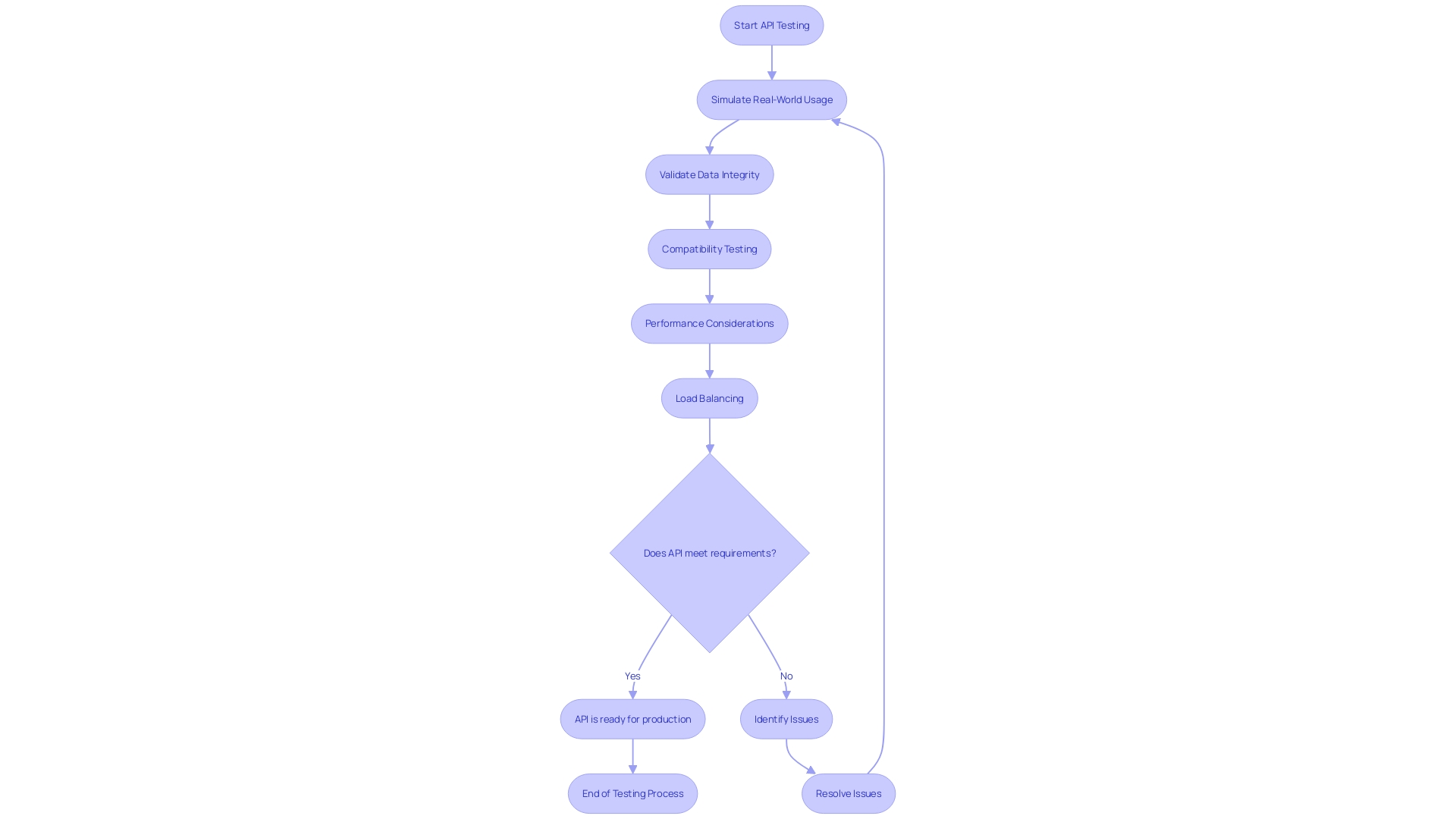
Security and Authorization with API Gateway
API Gateway, the centralized conduit for managing microservices, has become an integral part of modern enterprise information systems. With the ever-growing demands of enterprises and the frequent changes in internal personnel, the necessity for flexible and secure management of internal and external resources is paramount. By utilizing LDAP Single Sign-On (SSO), API Gateway offers a secure and unified access point that simplifies the connectivity and administration of various offerings. It excels in enhancing the security and reliability of enterprise systems by reducing risks such as password leakage and offering improved user efficiency and experience.
The concept of API Gateway security is akin to a secret communication code. It ensures that information is shared through secure, encrypted channels. When considering access management in a microservices architecture, there are two main strategies: decentralized access control, where each microservice acts as a gatekeeper, and centralized access control through an API Gateway. The second one acts as a sole source of authority, streamlining the administration of access across various offerings.
Recent reports underscore the urgency of robust API security. A staggering 78% of cybersecurity teams have encountered an API-related security incident within the past year. Despite the majority having a comprehensive inventory of APIs, only 40% have insight into which APIs handle sensitive data, leading to 81% of organizations prioritizing API security more than ever before.
To fortify API security, it's essential to understand and implement authentication, authorization, and endpoint protection using API keys or AWS IAM roles. Authentication verifies user identity, ensuring that the entity requesting access is legitimate, while authorization determines the permissions of the user, delineating what they can and cannot do within the system. The importance of these security measures cannot be overstated as they form the first line of defense against sophisticated cyber threats targeting API vulnerabilities. By taking a proactive approach to API security, enterprises can safeguard their digital assets and maintain trust with their customers and stakeholders.
Best Practices for Using Lambda with API Gateway
Implementing optimal methods for function and API Gateway integration is crucial for guaranteeing that your APIs are not only efficient but also scalable. By centralizing control through API Gateway, you gain the strategic advantage of managing resiliency patterns across all components uniformly. This simplifies the implementation of important features such as error handling, logging, and monitoring.
Error handling is particularly crucial; it's about more than just capturing errors—it's ensuring that your application remains reliable and user-friendly. Employing robust error handling techniques is key to mitigating issues and improving the robustness of your APIs.
Furthermore, with the rapid expansion of data, as encountered by Adadot, which handled more than 200 million function calls in the course of one year, it becomes evident that efficiently acquiring and handling substantial amounts of data is a fundamental aspect of contemporary software engineering. The shift to serverless architectures can offer 'infinite' scalability, contingent on financial resources, and can be incredibly cost-effective with low traffic volumes.
AWS continues to innovate, offering events such as AWS Innovate Online, where challenges in technical domains like serverless are tackled. It's a testament to the evolving landscape of cloud services and the need for ongoing education and adaptation to the latest technologies and best practices.
In conclusion, by adopting a well-planned strategy for error handling, logging, and monitoring when using the combination of API Gateway and a serverless function, you can develop robust, responsive, and precise APIs that endure and grow with your business requirements.
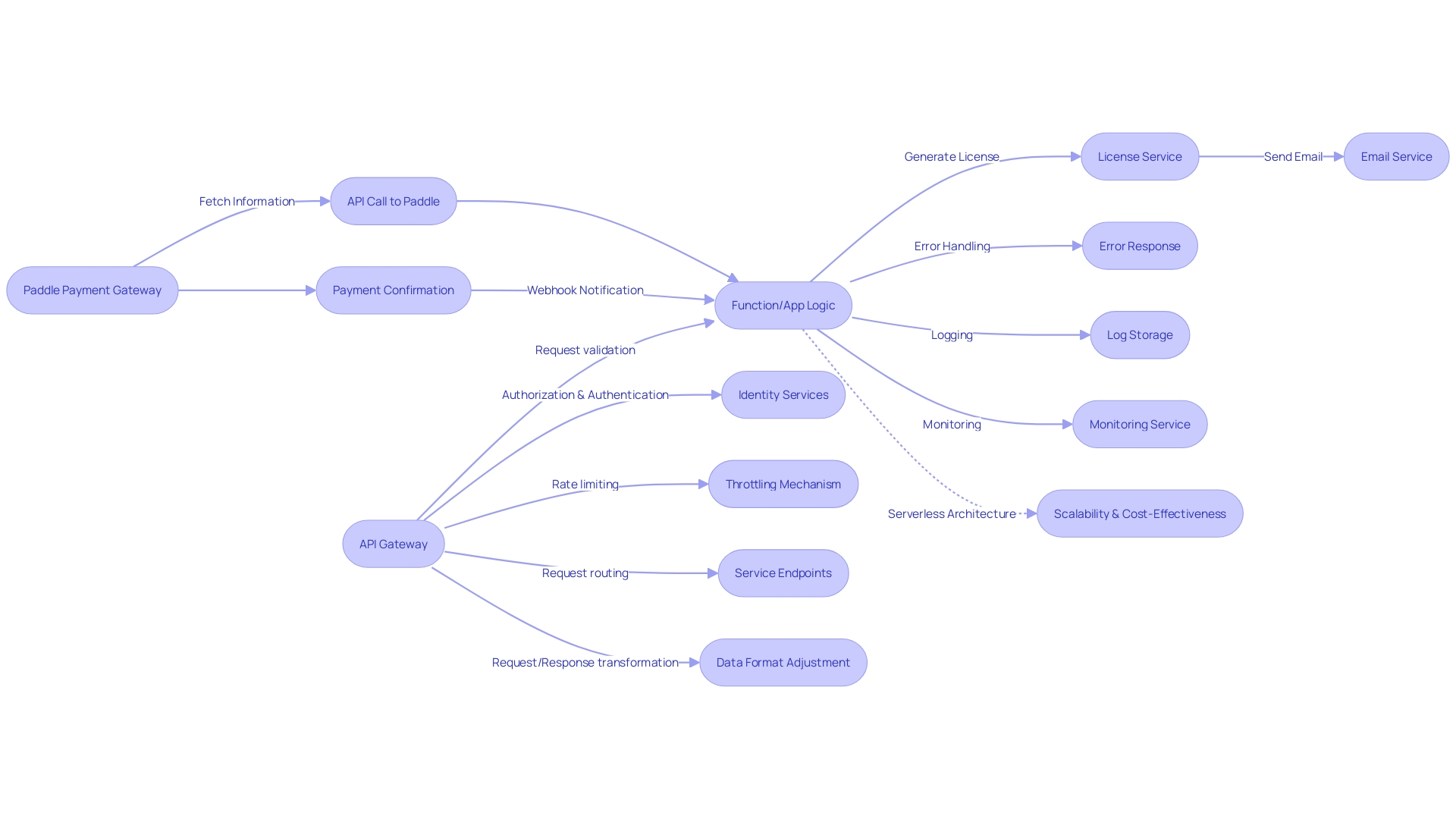
Advanced Use Cases and Examples
Utilizing the power of AWS in combination with API Gateway offers a wide range of possibilities for managing real-time data and customizing authentication processes. Real-time data streaming, for instance, transcends the traditional batch processing approach, offering a continuous flow of data that is processed instantly as it arrives. This dynamic method is akin to a constantly flowing river of information, where data is analyzed and utilized for immediate alerts, actions, analytics, or machine learning processing.
With Amazon Kinesis Data Streams and AWS Function as a Service, you can effortlessly consume and insert records into the stream, providing a comprehensive understanding of the service for both novices and seasoned professionals. Additionally, Amazon EventBridge Pipes presents an innovative alternative to AWS function for real-time record consumption from streams. For a more streamlined data processing pipeline, Amazon Kinesis Firehose can be utilized alongside AWS Function to transform records almost instantaneously.
The incorporation of AWS functionalities with API Gateway and the serverless computing platform not only improves data management capabilities but also strengthens the security and performance of your digital infrastructure. This is supported by the fact that 93% of organizations recognize the relevance and essential nature of APIs, as revealed by Vanson Bourne's research, 'The State of APIs, Integration, and Microservices'. Moreover, 97% of respondents acknowledge the complementary relationship between APIs and microservices, advocating for their unified integration to optimize performance and yield benefits such as elevated customer satisfaction, augmented productivity, and time savings.
The significance of this integration is further exemplified by innovative approaches like the Northwestern University Libraries' (NUL) digital collections suite. By embracing the International Image Interoperability Framework (IIIF) standards, NUL has successfully centralized its infrastructure to facilitate efficient global sharing of cultural heritage collections. The suite's image API allows researchers to conduct in-depth analysis with optimized bandwidth usage, demonstrating the transformative impact of AWS services in real-world applications.
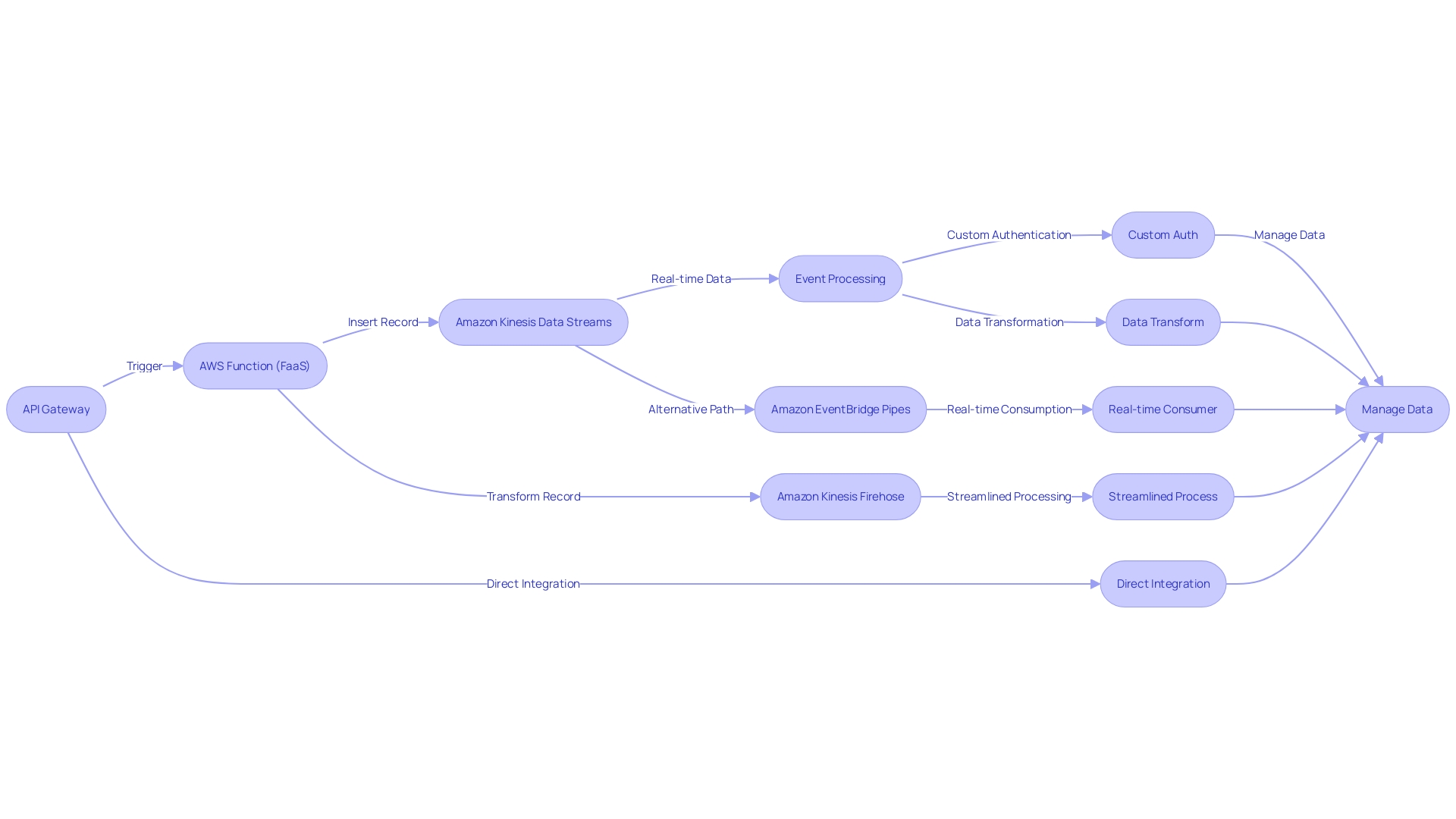
Troubleshooting Common Issues
Troubleshooting AWS functions and API Gateway can sometimes be challenging due to the intricacies of serverless computing. Professionals with years of experience in the field have shared insights on common 'pain points' encountered, such as architectural difficulties and complications in error resolution. Leveraging these lessons can streamline the process of managing your APIs. A crucial aspect of addressing issues is understanding and utilizing error messages effectively. For instance, AWS Lambda destinations provide detailed information including request and response payloads, error messages, and types upon function execution failures. Such information is invaluable for diagnosing the root cause of failures. In practice, companies like Contentsquare have adopted microservices and tools like Apache Kafka to build robust notification systems, which can scale and handle errors efficiently. In addition, maintaining a watchful eye on the health of your AWS account and staying updated on interruptions can preempt potential problems. AWS provides a personalized view of your account's status, updating in real-time, which can be instrumental in preempting and addressing issues promptly. For example, monitoring latencies and identifying whether they originate from specific components like Schematic or are due to front-end latencies can help in pinpointing the source of timeouts. In one analysis, a single project's endpoint latency stood out significantly, which led to the identification of the culprit behind timeouts. By adopting a methodical approach to troubleshooting, informed by real-world experiences and a comprehensive understanding of AWS services, you can ensure the smooth operation of your APIs.
Conclusion
In conclusion, AWS Lambda and API Gateway offer a powerful and cost-effective solution for building efficient and scalable cloud-based applications. Lambda eliminates the need for managing servers, operating systems, or language environments, allowing developers to focus on code. It seamlessly integrates with other AWS services and automatically scales with workload.
API Gateway simplifies API creation, deployment, and management, providing essential features like request validation, authorization, rate limiting, and routing. It's a fully managed service that frees developers from infrastructure management.
Integrating Lambda with API Gateway is crucial for efficient API request handling. It provides a single entry point and enables request and response transformations for customization.
When creating a REST API with Lambda integration, follow best practices like clean code, defining resource endpoints, and leveraging additional AWS services like Amazon DynamoDB for data management.
Configuring API Gateway for Lambda involves advanced configurations like request and response mappings, error handling, and caching to enhance functionality.
Testing and deploying the API requires meticulous testing for robust functionality. Consider performance aspects like load balancing and modularity.
Security and authorization with API Gateway are paramount for protecting systems and managing resources. Leverage LDAP Single Sign-On and implement authentication and authorization measures.
Adopt best practices for Lambda and API Gateway integration, such as error handling, logging, and monitoring, for performant and scalable APIs.
Advanced use cases demonstrate the power of Lambda and API Gateway in handling real-time data and customizing authentication processes.
Troubleshooting common issues requires understanding error messages and using tools like Lambda destinations. Stay updated on service interruptions and monitor account health.
In summary, AWS Lambda and API Gateway provide a robust and secure solution for building efficient and scalable APIs. Follow best practices, integrate effectively, and leverage the full potential of these services to create innovative applications without infrastructure management.




